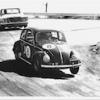
Bristol 405 - who knows what this is about?
#1

Posted 17 August 2011 - 17:06
http://www.uniquecar...bristol_405.htm
The Unique Cars and Parts site has always seemed to be pretty good to me, but this has me totally baffled. Note the engine capacity and number of cylinders?
Perhaps it's an April's Fool joke that someone forgot to correct when the second of April arrived?
What straight 8 engine could possibly be used in this, assuming there's some basis of fact in it? It does say only three cars built, but a supercharged 3257cc inline 8 is relatively small. The quoted horsepower could be right for such an engine. But I don't think it actually exists.
Anyone know more?
Advertisement
#2

Posted 17 August 2011 - 17:18
405 has normal 6 cyl engine etc.Saloon and Cab.
may be a special dreamt up by someone.
#3

Posted 17 August 2011 - 17:40
Nose seems long enough for the straight 8 but I doubt they only made 3-4 of that engine so if you can find that motor
used somewhere else then maybe they did build it. Would seem like a fun car to drive light weight and plenty of go power.
Buck
#4

Posted 17 August 2011 - 18:02
#5

Posted 17 August 2011 - 21:13
Even they have a real entry for the 405 (scroll down the page). which is more or less right.
Their search system doesn't lead to the offending page which must tell us something.
That certainly lives up to the "Unique Cars and Parts" title, don't it?
#6

Posted 17 August 2011 - 22:18
#7

Posted 17 August 2011 - 22:38
#8

Posted 17 August 2011 - 22:45
Here's their entry on the Bugatti 57SC Atlantic. As Duncan says, the engine and transmission details and number produced are the same. I suspect someone had finger trouble when putting the entries together:Bugatti seem to have used 3257cc straight 8s http://www.autoviva....?page=1&id=1572
http://www.uniquecar...sc_atlantic.htm
especially if one then checks their other Bristol details, eg:
http://www.uniquecar...bristol_402.htm
It's a nonsense, and can safely be ignored.
#9

Posted 17 August 2011 - 22:53
I can't think of any other that might have been used, even the Hudson was over 4-litres, though the very early ones were apparently around 220 cubes, as were the early Buicks. But you don't use an engine from the early thirties in a car built in the early fifties, do you?
A bit of a mystery, I think.
#10

Posted 17 August 2011 - 22:55
There were originally three T57G "Tanks", fitted with 3257cc engines. They were, however, unblown. A blown version, the T57C, won Le Mans in 1939. Other similar cars were the T57S45, which had a 4.5 litre T50B engine, and a hybrid T57/59.Bugatti seem to have used 3257cc straight 8s http://www.autoviva....?page=1&id=1572
You can pick the bones out of that, but I'd venture to suggest that somebody started a T57G page and then put the wrong title on it.
#11

Posted 18 August 2011 - 01:19
Good think we all like a mystery...
#12

Posted 18 August 2011 - 07:56
Even that has its howlers such asHere's their entry on the Bugatti 57SC Atlantic. As Duncan says, the engine and transmission details and number produced are the same. I suspect someone had finger trouble when putting the entries together:
http://www.uniquecar...sc_atlantic.htm
The car sat on elegant 15" wire wheels, and was fitted with drum brakes.
T57 Bugattis were on 18" wheels and I doubt anything was on 15" in 1937/8 but if it were it would be a very small car. Also when writing of a 1937/8 car the drum brakes are not worthy of comment.
As for power, Conway quotes 57S at 170 and 57SC at 200 at 5-6 p.s.i. boost (not 3-4 as in car sand parts).
#13

Posted 18 August 2011 - 10:18
And when you compare it to Barrie Price's book on the T57 it's obviously pretty much complete tosh! The writer may have been seeking to simplify, but has only succeeded in introducing confusion in what is already a complicated story. There was only one T57SC as originally built (c/n 57561, sold as a rolling chassis), although other cars were converted later and if I read Price correctly there was actually only one T57SC Atlantic - c/n 57591, which started life as a T57S.Even that has its howlers such as
The car sat on elegant 15" wire wheels, and was fitted with drum brakes.
T57 Bugattis were on 18" wheels and I doubt anything was on 15" in 1937/8 but if it were it would be a very small car. Also when writing of a 1937/8 car the drum brakes are not worthy of comment.
As for power, Conway quotes 57S at 170 and 57SC at 200 at 5-6 p.s.i. boost (not 3-4 as in car sand parts).
I also discovered another T57 model of which only three were built - the Jean Bugatti/Walter-designed Aravis drophead coupé, constructed by Gangloff. Presumably unblown, though.
#14

Posted 18 August 2011 - 11:40
The car sand parts piece also seems to move seamlessly from Atlantic to Atalante without making much of the difference.
#15

Posted 18 August 2011 - 11:49
#16

Posted 18 August 2011 - 12:31
Do I have to do all of the dirty work?
#17

Posted 18 August 2011 - 12:42
Wasn't the Aravis car one of the many body styles available on a 57 chassis rather than a separate model? I haven't got Barrie Price's book, but I'm surprised that only one 57SC was built. Does he really say that?And when you compare it to Barrie Price's book on the T57 it's obviously pretty much complete tosh! The writer may have been seeking to simplify, but has only succeeded in introducing confusion in what is already a complicated story. There was only one T57SC as originally built (c/n 57561, sold as a rolling chassis), although other cars were converted later and if I read Price correctly there was actually only one T57SC Atlantic - c/n 57591, which started life as a T57S.
I also discovered another T57 model of which only three were built - the Jean Bugatti/Walter-designed Aravis drophead coupé, constructed by Gangloff. Presumably unblown, though.
Am I correct in thinking that the only difference between the 57 and the 57C, and between the 57S and the 57SC, was the addition of a supercharger?
#18

Posted 18 August 2011 - 13:00
Edited by arttidesco, 18 August 2011 - 13:01.
#19

Posted 18 August 2011 - 14:25
Yes, you are correct about the Aravis there, Roger, although it's really just semantics, given the large number of body styles on T57 mechanicals ;) The first Aravis was unblown, the other two were supercharged.Wasn't the Aravis car one of the many body styles available on a 57 chassis rather than a separate model? I haven't got Barrie Price's book, but I'm surprised that only one 57SC was built. Does he really say that?
Am I correct in thinking that the only difference between the 57 and the 57C, and between the 57S and the 57SC, was the addition of a supercharger?
The 57S was a "sports" short-chassis version - 2.98m as opposed to 3.30m - and the C does indeed represent the presence of a blower: in the chassis list it seems that only cars which had them fitted as original equipment at Molsheim received the C designation. Regarding the T57SC, the exact quote from page 157 - discussing the T57S - is "One car was fitted with a supercharger and called Type 57SC. Several cars were converted by the factory to this specification during their early life." Although he doesn't detail all of those, the photo captions identify 57573 (an Atalante coupé) and 57602 (a Corsica-built Vanden Plas coupé).
The basic specification of the T57S - which incorporated De Ram shocks, a split front axle, dry sump lubrication and several other features - was much higher than the "ordinary" T57 and Price quotes a price of £1100 as against £590: it seems likely that this price disparity and the availability of the T57C at £745 were the main reasons why only 42 were built. Of the final ten T57S chassis, delivered between September 1937 and May 1938, seven (possibly eight) seem to have been sold to British customers and one to Italy - the presumed (by me) Italian being called Rovere: Gino of that ilk, perhaps?
Advertisement
#20

Posted 18 August 2011 - 22:49
Well, it was your discovery.How come that's my job?
Do I have to do all of the dirty work?
And it's an Aussie website. You know they wouldn't take kindly to being corrected by some whingeing Poms.
#21

Posted 18 August 2011 - 22:56
#22

Posted 19 August 2011 - 13:42
It got MCD... 'Modern Car Disease', which afflicts the drivetrain and forces all the horsepower to escape via the front wheels.
#23

Posted 20 November 2013 - 16:59
What I find sad is the owner wanted to chop the roof and install a slush box in the first place.
Why bother?
#24

Posted 20 November 2013 - 17:26
This is just typical of a short sighted lawyer. Demanding compensation and probably bankrupting the already fragile company in the process. It's no wonder insurance premiums are so high with this short sighted ness. If he is a member of the club, he should be thrown out...
#25

Posted 20 November 2013 - 17:53
What I find sad is the owner wanted to chop the roof and install a slush box in the first place.
Why bother?
Yes indeed, why bother as it says he bought a 405D.
If so, it is a drophead coupé to start with so he didn't need to "chop the roof" as you so happily put it.
Here's a 405D:

Edited by Allan Lupton, 20 November 2013 - 17:55.
#26

Posted 20 November 2013 - 20:00
Can I ask a question please? I have always believed that the supercharged 57 was a C i.e. Compresseur, whilst the unsupercharged version was an SC i.e. Sans Compresseur, after all it is a French nomenclature. Why would they refer to "Supercharging" and abbreviate it to S/C, the Insitute Francaise would be going round fast enough to solve the new power station problem?
Edited by Sharman, 20 November 2013 - 20:02.
#27

Posted 20 November 2013 - 21:14
A little learning is a dangerous thing: the letter S can stand for Sport as well as sans.
Simply put (by one who doesn't necessarily know, but knows what to refer to!)
Type 57 was the original car in 1934 with 135 b.h.p.
Type 57C was the supercharged version of the 57 (from 1937) with 160 b.h.p.
Type 57S introduced in August '36 had a modified shortened (by 32 cm.) chassis and some engine refinements to give 170 b.h.p.
Type 57SC was a supercharged 56S (from '37) with 200 b.h.p.
#28

Posted 20 November 2013 - 21:32
A little learning is a dangerous thing: the letter S can stand for Sport as well as sans.
Simply put (by one who doesn't necessarily know, but knows what to refer to!)
Type 57 was the original car in 1934 with 135 b.h.p.
Type 57C was the supercharged version of the 57 (from 1937) with 160 b.h.p.
Type 57S introduced in August '36 had a modified shortened (by 32 cm.) chassis and some engine refinements to give 170 b.h.p.
Type 57SC was a supercharged 56S (from '37) with 200 b.h.p.
56S? Typo or something else Allan?
#29

Posted 20 November 2013 - 21:34
A little learning is a dangerous thing:
Indeed it is Alan. In Bugatti-speak 'S' stands for 'Surbaissé' or 'lowered'. The 'S' chassis is completely different to the normal T57 chassis, notably at the rear where the axle passes through a 'hole' in deep side-members.
ST ![]()


















